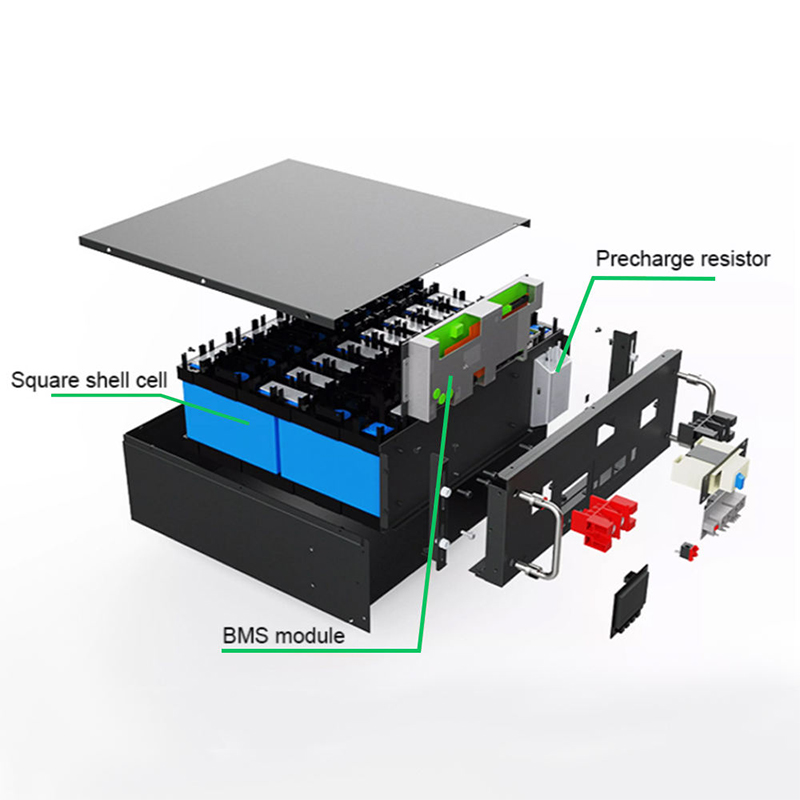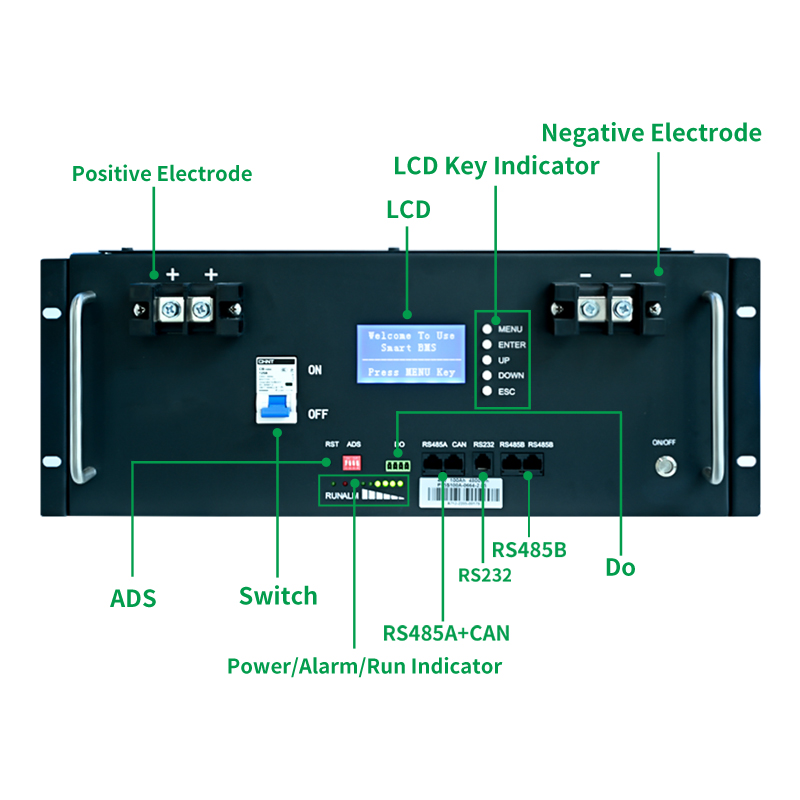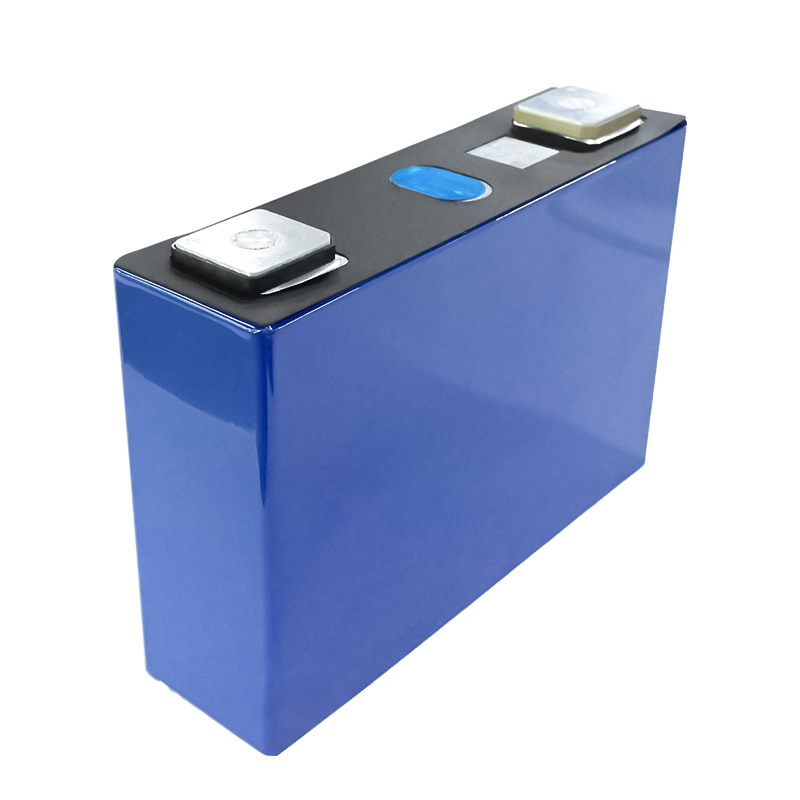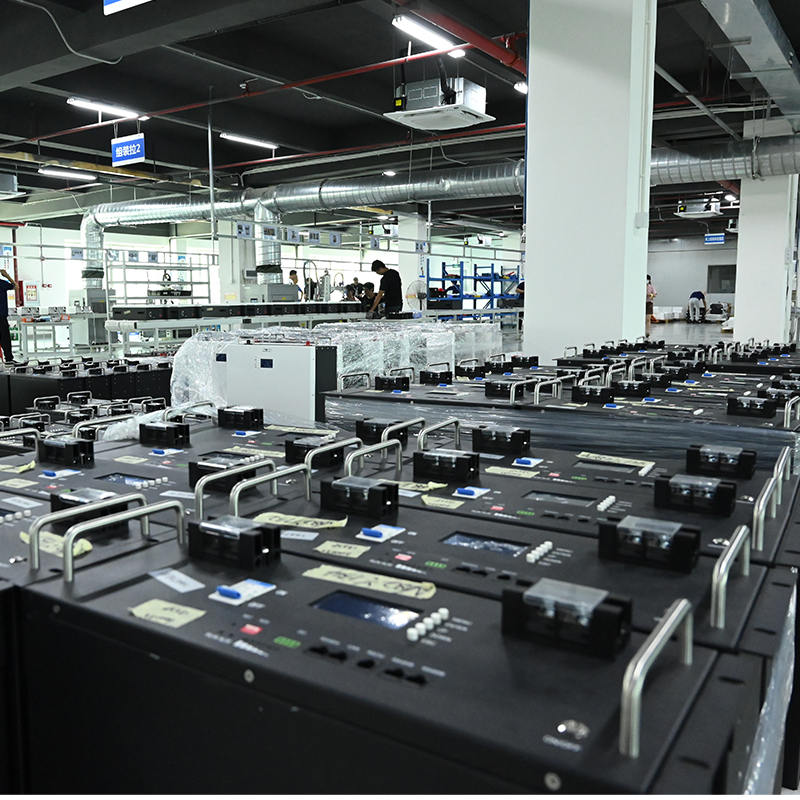A rack lithium battery refers to a configuration or arrangement of lithium batteries in a rack-like structure to create a battery bank with increased capacity and voltage. It involves organizing and connecting individual lithium battery cells together to form a larger and more powerful energy storage system.
Brand:
SunArkMax charging current:
100AOperation Voltage:
42-54VdcLife cycles (80% DOD, 25%):
6000 CyclesLithium battery standard:
UL1642.IEC62619.UN38.3.ROHS.CE-EMCOperation temperature:
20°C to 60°C @60+-25% Relative HumidityStorage temperature:
o°C to 45*C @60+/-25% Relative HumidityStorage time / temperature:
5 months @ 25°C. 3 months @ 35*C: 1 month @ 45°C
What does the BMS usually do?
BMS stands for Battery Management System. It is an essential component of a battery system, including rack lithium batteries, and plays a crucial role in monitoring and controlling the battery's operation. The primary functions of a BMS include:
State of Charge (SOC) Monitoring: The BMS tracks the battery's SOC, which indicates the remaining capacity or energy level of the battery.
Voltage Monitoring: The BMS continuously monitors the voltage levels of individual cells or battery modules within the battery pack.
Current Monitoring: By measuring the current flowing into and out of the battery, the BMS accurately estimates the battery's charge and discharge rates.
Cell Balancing: As a battery ages or experiences variations in performance, individual cells within the battery pack may have slightly different capacities or voltages.
Temperature Monitoring: The BMS monitors the temperature of the battery cells to prevent overheating or operating under unfavorable temperature conditions.
Overcurrent and Overvoltage Protection
Fault Detection and Diagnostics: The BMS continuously checks for any faults or abnormal conditions within the battery system.
Communication and Data Logging: Many BMS systems offer communication interfaces to interface with external devices or monitoring systems.

What main functions does the rack lithium battery have?
Here are some key functions of a rack lithium battery:
Energy Storage: Rack lithium batteries serve as a means of storing electrical energy for solar system.
Power Backup: Rack lithium batteries are commonly used as backup power systems in applications where a continuous and reliable power supply is critical.
Load Leveling and Peak Shaving: Rack lithium batteries can help balance the supply and demand of electricity in systems that experience fluctuating energy loads.
Renewable Energy Integration: Rack lithium batteries play a crucial role in renewable energy systems by providing energy storage for intermittent energy sources like solar or wind power.
Hybrid and Electric Vehicles: Rack lithium batteries are commonly used in hybrid and electric vehicles to store electrical energy for propulsion.
Overall, the function of a rack lithium battery is to provide reliable and efficient energy storage in various applications, enabling a more sustainable and flexible use of electrical power.

What is the main feature of LiFePO4 cells?
LiFePO4 battery cells offer several advantages over other lithium-ion chemistries:
Safety: LiFePO4 chemistry is inherently stable and less prone to thermal runaway or combustion, making it one of the safest lithium-ion chemistries available. It is less susceptible to overheating and overcharging, reducing the risk of accidents or fire hazards.
Long Cycle Life: LiFePO4 cells have a longer cycle life compared to other lithium-ion chemistries. They can withstand a higher number of charge-discharge cycles without significant capacity degradation, making them suitable for applications that require frequent use or high cycling.
High Energy Density: While LiFePO4 does not have the highest energy density among lithium-ion chemistries, it offers a good balance between energy density and safety. It provides a reliable energy storage solution that meets the needs of various applications without sacrificing safety.
Wide Operating Temperature Range: LiFePO4 cells perform well across a wide range of temperatures, including both low and high extremes. They have a better performance and longevity in low-temperature conditions compared to other lithium-ion chemistries.
Fast Charging Capability: LiFePO4 cells can handle high charge and discharge rates, allowing for fast charging and discharging without sacrificing performance or affecting battery longevity.
LiFePO4 battery cells are commonly used in various applications, including electric vehicles (EVs), hybrid electric vehicles (HEVs), energy storage systems (ESS), uninterruptible power supplies (UPS), portable electronics, and renewable energy systems. They provide a reliable and safe energy storage solution in these applications, ensuring long-lasting performance and enhanced safety.

How do we produce our lithium batteries?
Here are some main steps to produce rack lithium batteries:
Determine the battery bank requirements: Calculate the desired capacity and voltage for your battery bank based on your application needs.
Select suitable lithium batteries: Choose lithium batteries that meet your requirements and are designed for use in a rack configuration.
Choose a racking system: Select a racking system that is designed for the specific lithium batteries you are using.
Prepare the rack: Install the racking system and ensure it is securely mounted and stable.
Connect the batteries: Install the lithium batteries in the rack, following any guidelines provided by the battery manufacturer.
Configure the battery management system (BMS): If your lithium batteries require a BMS, install and configure it according to the manufacturer's instructions.
Test and verify: Once the batteries are properly racked and connected, perform thorough testing to ensure proper functioning and performance.
Remember that working with lithium batteries can be hazardous if proper precautions are not taken. Always follow the manufacturer's instructions and guidelines, and if you are unsure about any aspect of racking lithium batteries, consult an expert or seek professional assistance.
FAQs:
Q1: Is OEM/ODM service available?
A:Definitely, OEM&ODM service is supported with a certain quantity,including customize logo,package and label;
Q2: What's the production time?
A: The production time is normally 15 working days. but we will always prepare some stocks for popular models.
Q3: Do you support DDP service?
A:Yes, if you are a personal customer and don't want to deal with the customs, we can provide DDP service to your address.
Q4: What about the warranty and how to claim?
A: Warranty are 10 years since you receive the battery, our professional after-sales team will deal with all warranty issues.